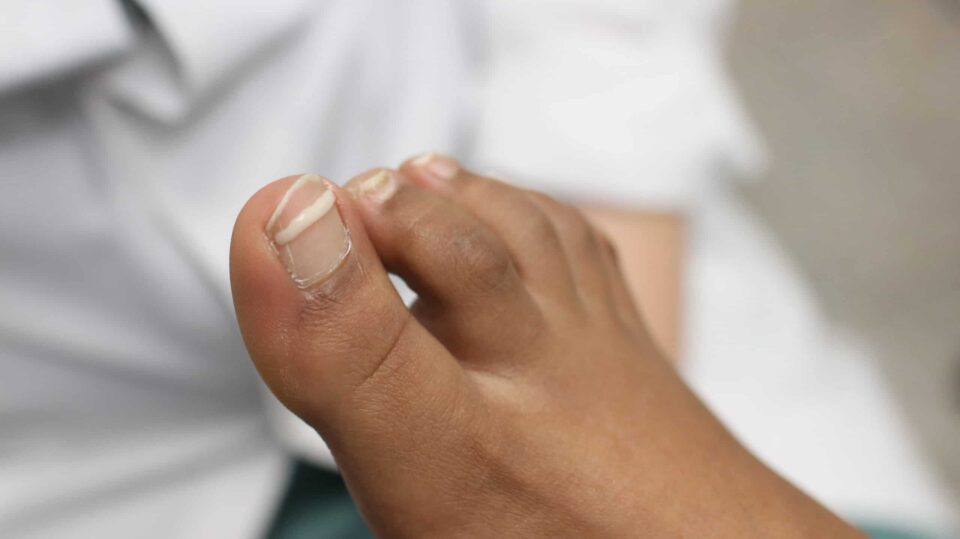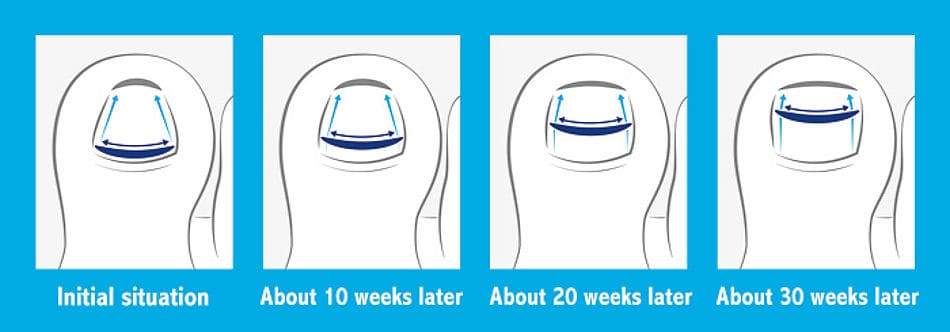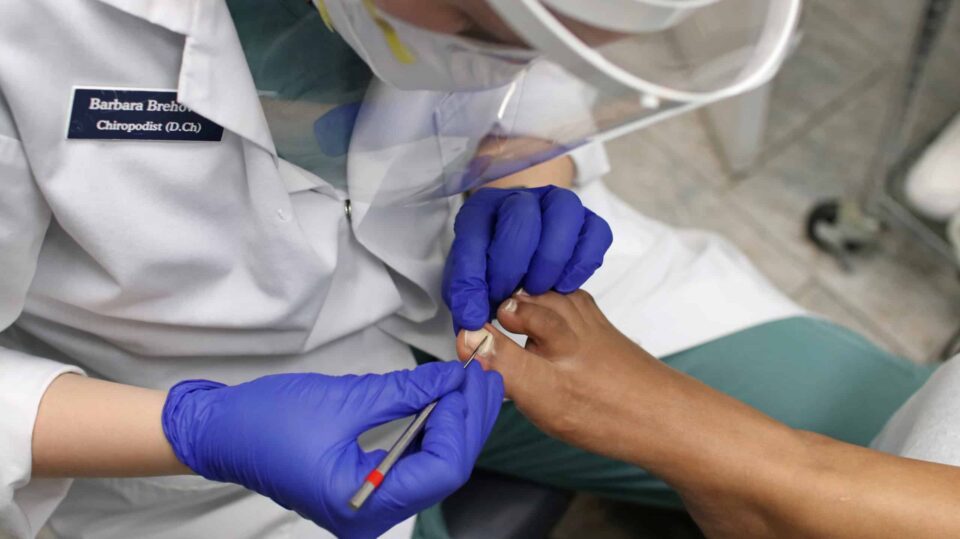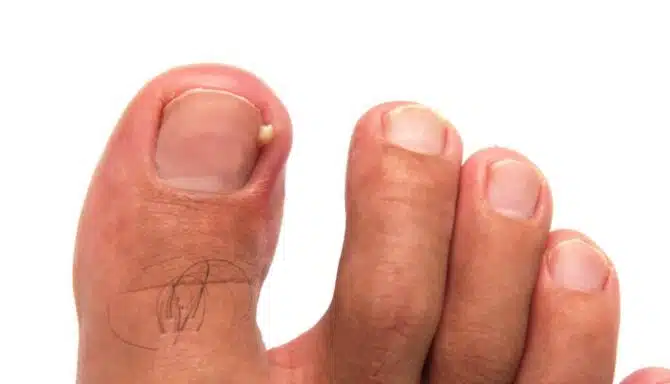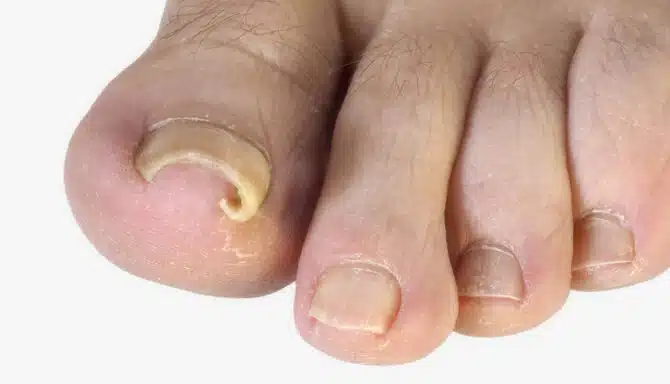April 18, 2024
Innovation has always been important in the healthcare world, with chiropody and innovative foot treatments being no exception! These days, with advanced foot care, you can enjoy pain management and comfort without resorting to a time-consuming ordeal like surgery. Let’s explore the services you can participate in thanks to innovation and great ideas!
Innovative Treatments for Common Foot Problems in 2024
Confusing and lengthy procedures can cause you to neglect the foot condition you may be struggling with, so modern treatments should save you time and put you at ease! Here are some of the best innovative treatments available today:
Shockwave therapy
Custom orthotics
Video gait analysis
Onyfix
Splinting and taping
Shockwave Therapy
Healthcare professionals have been using shockwave therapy to address musculoskeletal conditions since the 1980s. While the term “shockwave” can be off-putting, it’s a totally non-invasive procedure and most patients report very mild discomfort and no pain.
Shockwave therapy is quickly shaping up to be one of the best Achille’s tendonitis, Morton’s neuroma, and plantar fasciitis solutions. It works by targeting injured tissues, boosting blood circulation and stimulating a natural healing response in our bodies.
To learn more about shockwave therapy, click here.
Custom Orthotics
Orthotics date back to ancient civilization when humans started to realize their feet needed more support! As the centuries passed, they have become one of the most innovative treatments because now chiropodists and manufacturers can mold them to fit your specific needs. Custom orthotics treat a wide range of conditions and help correct your gait.
To learn more, click here.
Video Gait Analysis
A video gait analysis uses technology and visuals to determine what type of unique gait (walking pattern) you have. Think of it as a much more advanced version of walking on a treadmill! It gives your chiropodist the insight they need to help you correct it and avoid pain as much as possible.
To learn more, click here.
OnyFix
Imagine if you could alter your nail growth pattern without using invasive tools? Primarily used as an ingrown toenail treatment, OnyFix uses composite material to ensure your nails grow evenly and correctly! It’s one of the newest chiropody treatments and only became popular in North America within the past decade or so.
To learn more, click here.
Splinting, Taping and Correction
Tapes, splints and other devices can help people manage foot deformities without surgeries. For example, patients often experience bunion relief with bunion correctors, which are both affordable and comfortable and put your toes in an optimal position. Splinting and taping can also do the same for various conditions!
To learn more, click here.
January 15, 2024
At some point, we've all experienced the discomfort of a pesky ingrown toenail. It occurs when the nail plate grows into the surrounding skin and causes inflammation. Ingrown toenails are among the most common toenail conditions and are particularly common in the big toe.
Whether it's a result of a stubbed toe, improper nail-trimming habits, or the perils of snug footwear, ingrown toenails can quickly turn into a painful ordeal. In this article, we'll delve into the causes behind these troublesome toenail invaders, explore effective home remedies to ease the discomfort, and discuss when to seek professional help for a more permanent solution.
Causes of Ingrown Toenails
Improper nail trimming
Cutting toenails too short or rounding the edges can encourage the nail to grow into the skin. The skin surrounding the nail should not be higher than the toenail as this may cause the nail to grow into the skin instead of on top of it. Instead, cut the nail to the skin's edge and not any deeper.
Ill-fitting shoes
Tight or narrow shoes can pressure the toes, causing the nails to grow abnormally.
Injury or trauma
Stubbing your toe or other injuries can lead to ingrown toenails.
Genetics
Some people may have a genetic predisposition to ingrown toenails.
Poor foot hygiene
Not keeping the feet clean and dry can affect the skin around the nail bed, and contribute to the development of ingrown toenails.
At-home remedies for Ingrown Toenails
At-home remedies are an option while you wait for professional treatment. Note: Never attempt to cut the ingrown toenail yourself.
Warm soaks
Soak the affected foot in warm water for 15-20 minutes daily to reduce inflammation.
Cotton ball or dental floss
Gently lift the ingrown edge of the nail and place a small piece of cotton or dental floss underneath to encourage the nail to grow above the skin.
Antibiotic ointment
Apply an antibiotic ointment to prevent infection.
Wear proper footwear
Choose shoes with enough room for your toes, and avoid tight-fitting footwear.
Avoid aggravating activities
If possible, avoid activities that put extra pressure on the toes.
Professional treatment remedies for Ingrown Toenails
At-home treatment is only so effective. When in doubt, it's best to consult a professional for proper care and treatment. A chiropodist or foot specialist may perform any number of the following professional treatments:
Proper toenail care and trimming
Cutting toenails too short or at the wrong angle can cause ingrown toenails. A chiropodist can properly trim and cut your toenails in a way that promotes proper nail growth. They can trim to treat an existing ingrown toenail, or trim your toenails preventatively, for example, during a medical procedure or nail care appointment.
A chiropodist can also soften the skin, lift the edge of the nail from the skin, and then prop the corner of the nail over the skin edge until the skin heals. Finally, as it relates to toenail care, a specialist may apply a freezing gel or a Lidocaine to remove the ingrown portion of the toenail.
Onyfix
Onyfix is a special composite material that the chiropodist applies it in a band across the nail. It acts like a nail brace to correct the nail's growth.
Partial nail avulsion (PNA)
A local anesthetic first numbs the toe. A narrow vertical strip is then removed from the edge of the affected side of the nail down the entire length. Antibiotics and a dressing are applied to the exposed nail bed to prevent infection. This surgical procedure is performed if other treatment options do not work.
Total nail avulsion (TNA)
Total nail avulsion is similar to a partial nail avulsion, except the whole nail is removed. This surgical procedure is performed if other more conservative approaches are insufficient.
Phenol
This chemical is applied to the nail's root beneath the cuticle to prevent regrowth. It may be used during a PNA or TNA to prevent nail regrowth.
When to seek professional help for Ingrown Toenails
It can be challenging to differentiate what's serious versus not. Sometimes, minor ingrown toenails can be treated at home in their early stages. Other times, you should seek professional help. Here are a few scenarios that should have you consider seeking professional help:
Any signs of infection
If there is increased redness, swelling, or drainage of pus, it may indicate an infection that requires medical attention.
Moderate to severe pain
Seek professional help if the toenail pierces the skin or if you experience moderate to severe pain.
Persistent ingrown toenails
If ingrown toenails are a recurring problem, seeing a chiropodist for a more permanent solution may be necessary.
Underlying medical conditions
Individuals with diabetes or circulatory disorders should seek professional care for ingrown toenails at any stage.
It's essential to address ingrown toenails promptly to prevent complications. If you're unsure how to treat an ingrown toenail or suspect an infection, it's advisable to consult with a healthcare professional or podiatrist for proper diagnosis and treatment.
October 5, 2023
When it comes to toenail anatomy, certain factors can affect structure and growth pattern. Case in point: curly toenails. They don't look quite right and the truth is, there are several potential culprits. Sometimes it can be an underlying health condition presenting symptoms via your nails, and other times it is a direct toenail condition. As a side note, it's also wise to ensure curling toenails don't co-exist with/turn into ingrown toenails, which may become infected.
Let's take a look at what might be causing your curling toenails, and what you can do about it!
Causes of Curly Toenails
Onychomycosis
This is a fungal toenail infection in the nail unit (the nail plate, surrounding soft tissues and nail folds). It usually results in nail thickening and the formation of pincer nails (curly toenails).
Onychauxis
This nail disorder causes the toenails to thicken excessively, eventually causing the nails to curl and turn white or yellow. The nail plate may also separate from the nail bed. Diabetes patients in particular should be on the lookout for diabetes-related onychomycosis and onychauxis, or “ram horn,” and other severe abnormalities caused by toenail thickening and curling.
Autoimmune Illnesses and Deficiencies
Lupus, psoriasis, psoriatic arthritis and thyroid disorders can all cause thickened toenails that eventually degrade and curl. Severe iron deficiency can also cause curly toenails since iron is so critical for maintaining our nail and foot health.
Ill-Fitting Footwear
Perhaps the least serious cause of curly toenails is also the most avoidable — simply neglecting foot care and failing to buy shoes that fit well. Wearing shoes that are far too tight for years (perhaps because you’re procrastinating a proper shoe fitting) is a mistake. When you wear shoes with minimal space in the toe box, the shoe will squeeze both sides of the toe, disrupting normal nail growth and bending the nail root or matrix.
Medications
Drug-induced nail disease is a very real concern for those taking necessary medicines. Some examples of medications that cause curly toenails and other nail growth disruptions include antibiotics, chemotherapy drugs, lithium, and Retinoids.
Genetics
Sometimes your gene pool is responsible for your curly toenails. Your mom and dad can pass down hereditary characteristics like the shape and thickness of your toenails, as well as how much skin you have surrounding the toenails. But don’t worry if you feel like you have no control over genetic traits - proper foot care can still help you manage curly toenails.
Here are some of the best treatments for curly toenails:
Medical Pedicures: Chiropodists can properly clean and trim the nails to promote healthy growth.
Antifungal Medicines: These can help with onychomycosis.
OnyFix: Modern, non-invasive treatment that involves using a special paste to correct nail growth.
At-home foot care: Remember to keep your feet and nails clean, but don’t try to trim them on your own if they're severely curled or ingrown. If your toenails look like this, it's best to contact a chiropodist.
Diabetic foot care from a Toronto foot clinic.
August 22, 2023
Beau's lines are changes in your toenail anatomy and appearance that may indicate an underlying illness. These changes can be difficult to detect unless you inspect your nail health, so it's important to take note if you see them. Systemic illnesses, which affect the entire body rather than a single organ or body part, may be the reason behind your nail changes.
Photo by jannoon028 from FreePik
The Science Behind Nail Changes: Beau's Lines
Beau's nails generally look like deep, horizontal grooves that go from side to side, almost as if you have a band wrapped around your finger that astoundingly makes an indent in the nail. They can affect both adults and children.
They are your body's way of telling you, "Hey! I have too much to focus on right now, so I'm neglecting your normal nail growth pattern."
This means that Beau's nails aren't a problem but a symptom. Similar to your hair and skin, aesthetic changes to toenails and fingernails often serve as a warning your general health is under attack in some way. Research suggests that illnesses interrupt natural nail matrix growth and that the longer you suffer from an illness, the deeper the grooves can become.
Photo by Rawpixel.com from Freepik
Do Beau's Lines Mean Something Is Wrong With My Health?
Not necessarily, but systemic illnesses are often the reason behind these deep nail grooves. If you notice them, you should see your family doctor immediately. If you know you're suffering from an illness and notice Beau's lines, there is a high chance the two are connected. Beau's lines may also linger for a while after you've recovered from your illness or begin treatment.
You may have a serious illness if you have more than one nail with Beau's lines, but if you just have one, it may be from a toenail infection, blunt-force trauma injury, or exposure to cold temperatures. However, Beau's lines in all 20 fingernails and toenails often indicate disease or aggressive treatment for a disease, like chemotherapy.
Some common causes of Beau's lines include:
Heart attacks and poor heart health
Pneumonia
Strep infections
Measles
Mumps
Diabetes
High fevers/infections
Infections in the nail fold
Malnutrition
Skin disease
Thyroid conditions
Hypocalcemia (low calcium)
Raynaud's Disease
Severe emotional stress, traumatic life events, and generalized anxiety disorders can also wreak havoc on nail growth.
Treatment
Getting rid of Beau's lines depends on how successfully you treat the underlying cause, whether it be injury, illness, stress or infection. However, chiropody treatments like Onyfix or medical pedicures can help encourage proper nail growth and keep your nails clean while you treat the root cause.
May 15, 2023
Ingrown toenails can look harmless but can be pretty painful. What starts as abnormal nail growth can quickly turn into a full-blown ingrown toenail. When the nail edge grows into the surrounding skin, you'll experience pain, swelling, and redness.
If left untreated, ingrown toenails can worsen and possibly lead to infection. We're here to help prevent that from happening. In this guide, you'll learn more about how to prevent and treat ingrown toenails.
How to prevent ingrown toenails
Prevention of ingrown toenails goes hand-in-hand with proper foot and toenail hygiene. Healthy nails are not just for show; they're a critical part of our feet.
Trim your toenails straight across.
The safest and most effective method to prevent ingrown toenails is to cut your toenails carefully. We recommend cutting your toenails straight across and avoiding clipping the corners to round them off. Use a high-quality toenail clipper, one sturdy enough to handle the toughness of toenails (rather than using tools meant for fingernails).
Avoid cutting them too short, as the surrounding skin may grow over the nail. If you're ever in doubt about a proper toenail routine or how to cut your nails, book a medical pedicure so a foot specialist can eliminate the risk.
Keep toenails at a moderate length.
Trim toenails so they're in line with the tips of your toes as if you were to draw a straight line. Toenails cut too short may adversely affect the nail when you wear shoes. Pay close attention to any loose or jagged edges and those that can get caught and damage your nail.
Wear suitable footwear
Wear shoes that fit correctly and do not squeeze your toes together. Avoid shoes with a narrow-toe box. Tight shoes can force your toes together, putting your nail at risk of digging into the surrounding skin.
Practice good foot hygiene.
Foot hygiene involves a multi-faceted routine. Keep your feet clean and dry when possible. Regularly check your feet for any abnormalities or irregularities. And finally, book annual foot check-ups. Regular foot assessments are beneficial if you have diabetes or any other condition where you may be more vulnerable to foot issues.
How to treat ingrown toenails
Treatment of ingrown toenails typically comprises at-home treatment and professional treatment. There is more to risk by trying to treat ingrown toenails entirely by yourself, but at-home methods can help relieve pain and preserve the nail while waiting for an appointment at a foot clinic.
Generally, we do not recommend cutting the toenail yourself, as it may exacerbate the issue. Instead, try the following:
At-home treatment of ingrown toenails
Soak your feet in Epsom salt water to help soothe pain and discomfort. After soaking, gently massage the area around the ingrown toenail to help relieve pain and pressure.
Routinely clean the area of pus and blood, if needed.
Apply sparing amounts of Polysporin ointment and cover with a bandage when going out.
Wear shoes with a broader toe to accommodate added space in your footwear, thus reducing the pressure on the toes.
Avoid or reduce physical activity if such activity impacts your feet and toes.
Take pain relief medication as needed or as your doctor recommends to help control pain and discomfort.
Apply an antiseptic, such as hydrogen peroxide, to the affected area to prevent infection.
Professional treatment of ingrown toenails
Next, a professional can effectively treat ingrown toenails by doing the following:
Proper toenail care and trimming: A chiropodist can properly trim and cut your toenails in a way that promotes proper nail growth. Proper nail trims both treat existing ingrown toenails and can prevent them from occurring in the future.
Softening the skin, lifting the edge of the nail from the skin, and then propping the corner of the nail up over the skin edge until the skin heals.
Oral and topical antibiotics to prevent or heal the infection.
Safely lancing and draining pockets of pus (the toe is numbed first with a local anesthetic).
Applying a specially formulated composite material called Onyfix. It serves as a corrective brace for the nail's growth and can be used to treat recurrent ingrown toenails.
In more severe cases, surgery may be performed. This can can involve removing a narrow strip down the length of the toenail (partial nail avulsion (PNA), or removing the entire toenail (total nail avulsion (TNA). These procedures may be performed if more conservative, non-surgical treatments don't work.
Phenol can be applied to the nail's root beneath the cuticle to prevent regrowth. The method inhibits nail growth following PNA or TNA.
All treatments from a chiropodist use medical-grade products and a fresh set of sterilized instruments for each client. The sterilization process used by chiropodists will remove and kill all microorganisms, such as fungi, bacteria, viruses, and spores. We also thoroughly cleanse your feet with an alcohol solution at the beginning of every appointment.
November 17, 2022
A self-performed nail trim may seem like a simple task. However, many people make plenty of mistakes when trimming their nails.
Failing to follow the correct technique can lead to a wide array of painful toenail problems, like ingrown toenails (P.S. you should never try to cut your own ingrown toenails), cracked toenails, and even infections like toenail fungus.
In the world of podiatry and chiropody, a trim nail is serious business. There are guidelines to follow to protect your toenail health, and foot specialists also recommend specific tools of the trade. The good news is you can learn to trim your toenails properly from home.
Let's look at common toenail trimming errors (and useful tips) and then learn how to cut your toenails like a pro!
Toenail Trimming: Common Errors and Helpful Tips
Don't trim your toenails when they are wet. Everyday Health notes you should trim them while dry for a smoother cut.
Don't clip your toenails too short. This almost guarantees ingrown toenails, as the skin can overlap the toenail.
Use the right toenail clippers and avoid using unusual objects for toenail trimming, like standard scissors.
Curving the edges of your toenails may look aesthetically pleasing, but experts suggest not doing this. It will put you at risk of ingrown toenails, so trim your toenails straight across instead.
Clip your toenails every six to eight weeks. Don't wait longer, or it will be more difficult. Athletes may want to clip more frequently.
Maintain a toenail length of 1 to 2 mm, no shorter. Toenail growth can be quite slow sometimes.
If you don't have the right tools, enough time, or simply the confidence to focus on a nail trim, try a medical pedicure instead. It includes the right nail trimming procedure and concludes with a relaxing (and beneficial) moisturizing session, thorough cleaning, and more. Before the nail trim, a chiropodist also examines your feet for other foot conditions.
Try OnyFix if you're already burdened with ingrown toenails. This non-invasive, pain-free procedure ensures your toenails grow in the right direction.
How a Foot Specialist Cuts Toenails
Start with a clean, dry base. A clean base keeps your tools from slipping and eliminates debris so you can see the toenails clearly. Cut your toenails after a shower or bath and ensure they're dry, using a towel to soak up any excess water.
Use sharp nail clippers or nickel-plated pedicure scissors. Remember, toenails are thick, so flimsy tools will just cause mistakes.
Clip nails straight across. There should be no curving of the edges or cutting the nails down too far. A straight cut keeps the nail growing in the right direction.
Trim once more if needed. If the first trim doesn't look quite right, trim straight across one more time. Cut along the straight line of the initial cut to clean up the edges.
Use a nail file. This tool is necessary for properly smoothing the edges of the nails. After the trimming, there will likely be some jagged edges, sharp corners, and "spikes."
